
Bears, hogs among Big Cypress wildlife
OCHOPEE, Fla.— The Big Cypress National Preserve is 729,000 acres of lush landscape filled with hundreds of different wildlife inhabitants.
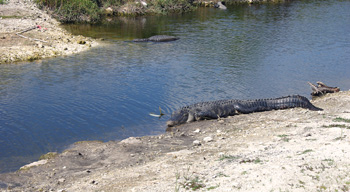 |
| Two alligator in one of the many waterways of the Big Cypress National Preserve (Photos by Tenille Lively). |
It is home to the red-cocked woodpecker, Florida black bear, Florida panther, wild hogs, alligators, crocodiles, white-tailed deer, Big Cypress fox squirrel and some exotic breads such as the Burmese Python and iguanas to name a few.
The inhabitants of Big Cypress are surrounded by freshwater marshes, dry and wet grasslands, pine and mangrove woodlands and cypress swamps.
Cypresses encompass about two-thirds of the preserve.
According to the National Parks Service, the name Big Cypress does not refer to the size of the trees, but the vast amount of the trees.
The preserve is the only area in the world where alligators and crocodiles exist in the same habitat.
The alligator is the state reptile and can be seen in abundance in Big Cypress. They can reach up to 20-feet long and weight an astonishing half ton. According to the NPS the longest alligator ever captured in Florida was over 14 feet long and weighed in at 800 pounds. The heaviest weighed 1,040 pounds and reached just under 14 feet long.
Although alligators and crocodiles co-exist there are a few markers to differentiate. The alligator has a wide snout with a rounded tip where as the crocodile’s snout is long and pointed. Another marker is the teeth pattern. The alligator’s bottom row of teeth overhangs the jaw line when the mouth is closed where as the crocodile’s fourth tooth is apparent.
The Florida panther is an endangered species in Big Cypress. There are about 87 panthers left in all of the Florida preserves.
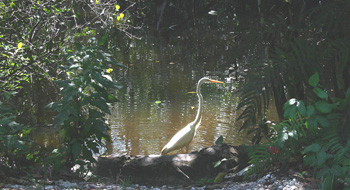 |
| A wildbird sits in the sunlight along a waterway, waiting to spot a fish. |
The dense growth of industry produces mercury that streams into the Everglades.
According to the NPS one panther found dead in a Florida preserve had levels of mercury that would be lethal even to humans.
The NPS has devised a system to monitor the panther’s behavior. Radio frequency telemetry collars are put around the panther’s neck to enable a capture team to examine the daily activities of the panther.
The habitat preferred by the panther includes hardwood swamps, pinelands and wet grasslands in the Bear Island portion of Big Cypress located north of I-75. Research shows that panthers in this area are healthier and raise more offspring.
The mountain lion is a threatened species due to the similarities to the Florida panther.
Also on the threatened list is the Florida black bear.
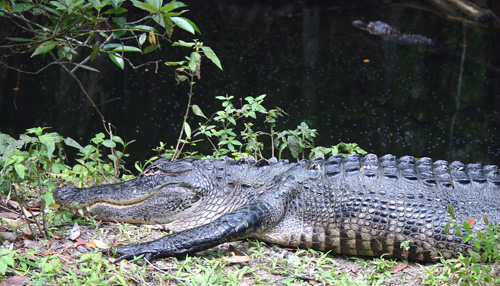 The number of black bears has decreased from what was thought to be 12,000 to between 1,500 and 1,000 in population.
The number of black bears has decreased from what was thought to be 12,000 to between 1,500 and 1,000 in population.
They are black in color with a brown muzzle and an occasional white torso.
The average weight of a male is 350 pounds and the female 150 pounds.
The black bear’s habitat is wetland and upland forests in Big Cypress.
They eat mostly vegetable type product such as acorns and palmetto hearts which are indigenous to Florida.
Like the Florida panther, growth of agriculture-related industry is a threat to the bear’s existence.
The West Indian manatee is also endangered. There population has diminished to around 1,900. Human contact is the main cause of the population decrease.
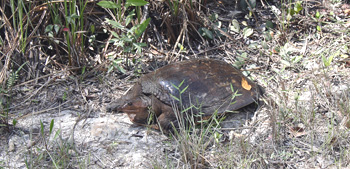 |
| A turtle takes a stroll in the Big Cypress. |
The average West Indian manatee is 10 feet in length and can weigh up to 1,200 pounds. Unlike the Florida black bear the females out weigh the males.
The bodily features include a protruding upper lip engulfed by trademark whiskers, grayish-brown skin and flippers used as a maneuvering guide.
They rely on vegetation as a food source and on the warm water climates that South Florida offers.
Other endangered species found in Big Cypress are the Florida mink and the Big Cypress fox squirrel.
The Big Cypress National Preserve offers several methods for viewing wildlife.
The preserve includes 31 miles of the Florida Trail, a backpacking trail which can be wet during the summer months of May trough October due to the rainy season.
For the more adventurous visitor, you may rent a canoe or kayak and paddle through the waterways of Big Cypress. Turner River, Halfway Creek and Barron River make the experience of wildlife viewing one to remember.
H.P. Williams Roadside Park provides camping and hosts wildlife talks on Sundays and Wednesdays.
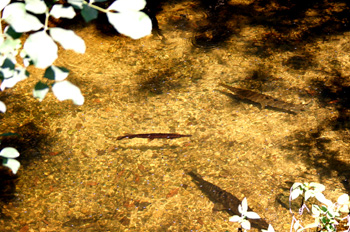 |
| The waterways of the Big Cypress can be so clear that the fish are easy to observe. |
Other attractions include hiking, biking, fishing, Kirby Storter Boardwalk, Turner Road and Loop Road.
Loop Road is a 26-mile unpaved trail that you may hike, bike or drive through.
It begins with Gator Trail.
The area is dense with cypresses and hard-wood trees called hammocks positioned in water streams. It is lush and sub-tropical and has an abundance of wading birds such as the ibis. Turtles and alligators basking in the sun are in plain view. You can even catch a glimpse of an otter agilely whirling in the waters.
Sweet Water Strand gives way to the Florida Tree Snail Trail. The trees become less dense, which makes the vividly colored Florida tree snail highly visible.
Along the way there is a fishing trail.
According to Ben West, a 62-year-old Florida native, who was fishing for red fish said the area used to be a part of an old alligator trapping zone.
Mosquitoes during the summer months are present.
Make sure you bring water, a camera and use the facilities before you leave on your trip. Binoculars for wildlife viewing are suggested.
For more information on wildlife viewing and regulations contact the Oasis Visitor Center at 800-788-0511 or go on line at http://www.nps.gov/bicy/ .

Comments are Closed